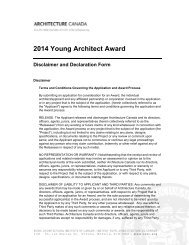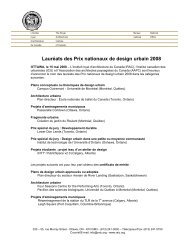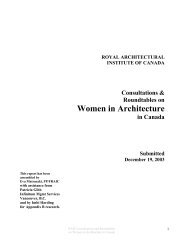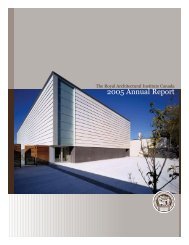Benchmark Study on Green Buildings - Royal Architectural Institute ...
Benchmark Study on Green Buildings - Royal Architectural Institute ...
Benchmark Study on Green Buildings - Royal Architectural Institute ...
Create successful ePaper yourself
Turn your PDF publications into a flip-book with our unique Google optimized e-Paper software.
Al<strong>on</strong>g with the percepti<strong>on</strong> that green technologies are more costly and risky than<br />
c<strong>on</strong>venti<strong>on</strong>al equipment, there is also the comm<strong>on</strong> percepti<strong>on</strong> that green development is<br />
more expensive because it takes l<strong>on</strong>ger to implement. From seeking qualified<br />
professi<strong>on</strong>als, to obtaining approval for an unc<strong>on</strong>venti<strong>on</strong>al design, to finding the right<br />
kinds of materials, many people see obstacles at every stage of the development process<br />
that can <strong>on</strong>ly lengthen the implementati<strong>on</strong> period. The percepti<strong>on</strong> is that the<br />
implementati<strong>on</strong> process for green development will be l<strong>on</strong>ger than for a standard building,<br />
and therefore costlier and less appealing.<br />
Often, a barrier to green buildings is that there is insufficient support and leadership by<br />
various levels of government. This includes insufficient government incentives,<br />
inc<strong>on</strong>sistent or uncoordinated regulati<strong>on</strong>, or the simple fact that the government may not<br />
be adequately pushing for green development. Because governments are usually the<br />
largest single owner of buildings in a country, they need to be very supportive of green<br />
building and encourage this type of development in any way they can. Implementing<br />
green practices in their own buildings is a great way for governments to dem<strong>on</strong>strate<br />
leadership and envir<strong>on</strong>mental resp<strong>on</strong>sibility.<br />
The lack of incentives and initiatives, both governmental and n<strong>on</strong>-governmental, acts as a<br />
barrier to green buildings. Incentives and programs make the creati<strong>on</strong> of green buildings<br />
more appealing to developers, who will then be more likely to build them. With more<br />
green buildings and homes available, more people will experience the benefits of these<br />
facilities. This helps increase awareness of the benefits of sustainable c<strong>on</strong>structi<strong>on</strong> and<br />
green buildings. So, increasing incentives and programs to encourage the manufacturing<br />
of green buildings is likely to help increase public awareness, and begin to breakdown the<br />
knowledge barrier.<br />
Lack of investment in green buildings is also a huge barrier to their widespread adopti<strong>on</strong>.<br />
The building industry is a significant comp<strong>on</strong>ent of any nati<strong>on</strong>al ec<strong>on</strong>omy, but there is<br />
still very little Canadian investment in innovative building practices and green<br />
technologies. For instance, the European Uni<strong>on</strong> spends 6 times more than Canada <strong>on</strong><br />
research c<strong>on</strong>cerning the built envir<strong>on</strong>ment and new building technologies.<br />
8.1.3 Technology, Products & Materials:<br />
Uncertainty about new and emerging green technologies is another barrier to the<br />
widespread implementati<strong>on</strong> of green buildings. Since many envir<strong>on</strong>mental technologies<br />
are relatively new, with less market history than c<strong>on</strong>venti<strong>on</strong>al technologies, many<br />
property owners and developers are c<strong>on</strong>cerned that payback will not be as promised and<br />
that these technologies will end up not being as effective or reliable as the wellunderstood<br />
c<strong>on</strong>venti<strong>on</strong>al equipment. Indeed, cost-benefit analysis of many green<br />
technologies is still being defined and the value in building green is often intangible, and<br />
is typically excluded from developers’ own cost-benefit analyses. Developers generally<br />
look for a payback period of between 3 and 7 years. However the payback period<br />
required with green technologies can be quite l<strong>on</strong>g, and c<strong>on</strong>siderably l<strong>on</strong>ger than many<br />
25

















